Inspired by the new Bulgari Octo Finissimo Tourbillon Chronograph Skeleton Automatic, I spent some time investigating the company’s family of “Finissimo” movements. Over the last six years, the ultra-thin Finissimo movements have taken record after record, from the exotic (tourbillon, repetition) to the commonplace (automatic). And they incorporate some serious engineering and clever thinking. Read on to learn all about the Bulgari Finissimo movements, from 2014 to 2020.
Jump right to the Bulgari Finissimo family, or stick around for some explanation and context!

Note: I choose to use “Bulgari” in text. The company is named for Sotirio Bulgari, and the Bulgari family ran the company until recently. The now-familiar styling of the name as “Bvlgari” dates to the 1970s and is widely used in text and official company publications, but is not commonly used in Switzerland or in the watch press.
The history of the Bulgari Octo Finissimo line stretches back to the 1970s, when designer Gérald Genta began using it as a signature element in his wristwatch designs, including the famous Royal Oak for Audemars Piguet. After its acquisition of his namesake brand in 2000, Bulgari began working on a new multi-faceted integrated case, which overlaid octagon on octagon in layers. The resulting watch was known as the Octo, and would be a staple in the Gérald Genta line from 2005 through the retirement of the Genta name in 2014.
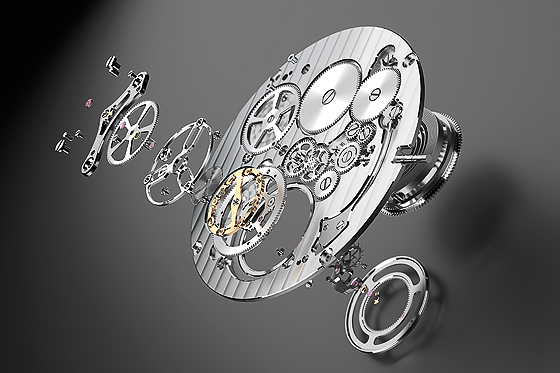
That year, Bulgari revealed an ultra-thin tourbillon in a new slim case. The Octo Finissimo Tourbillon stole the show at Baselworld 2014, the thinnest tourbillon watch ever created at just 5 mm. Cal. BVL 268 was truly remarkable, measuring just 1.95 mm to the top of the flying tourbillon cage. It incorporated very few jewels (just 11) due to the way the wheel train was mounted in the main plate: Like the historic Jean Lassale ultra-thin movements of the 1970s, it used ball bearings placed around the circumference of the barrel and wheels rather than jewels and pivots. everything was laid out in a single plane in a wide 14.5 ligne (32.60 mm) main plate. The original Octo Finissimo Tourbillon model remained in production until a skeleton model appeared in 2017.
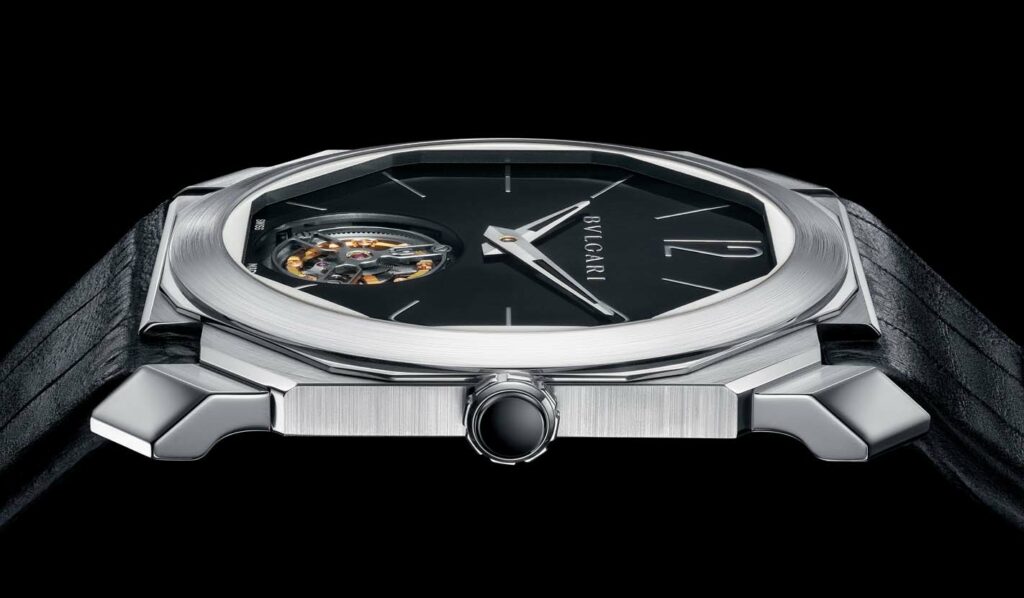

A few months later, Bulgari added a more accessible member of the Octo Finissimo line. The simply-named “Octo Finissimo” had the ultra-thin hand-winding Cal. BVL 128, allowing it to be just 5.15 mm thick. The design included a small seconds subdial at 7:30 on the dial, a novel feature that would become a signature of the less-expensive Octo Finissimo models. The movement was just 2.23 mm thick and included a power reserve indicator on the reverse, visible though a sapphire caseback. The 3-handed hand-winding Octo Finissimo was initially available only in platinum like the Tourbillon, though a rose gold model with a black lacquer dial soon appeared. These remain in production as of 2020, with a diamond bezel version added as well.
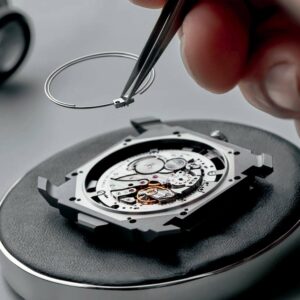
Skipping a year, Bulgari would set another record in 2016. The new Octo Finissimo Minute Repeater measured just 6.85 mm thick, the thinnest such watch ever produced. The movement, Cal. BVL 362, measured 3.12 mm, barely 0.02 mm thicker than the classic Vacheron Constantin Hour Lounge movement. Compared to the exotic tourbillon, this gave Bulgari more room to work so the movement has 36 conventional jewels and measures a classic 12.5 ligne (28.50 mm) in diameter. The dial featured cut-out index marks and acted as a sounding board for the chime. Production was limited to just 50 pieces, with a list price of over US$150,000. Bulgari produced a Carbon Thin Ply (CTP) version in 2018 and used the same movement in the Diva Finissima Minute Repeater that same year.
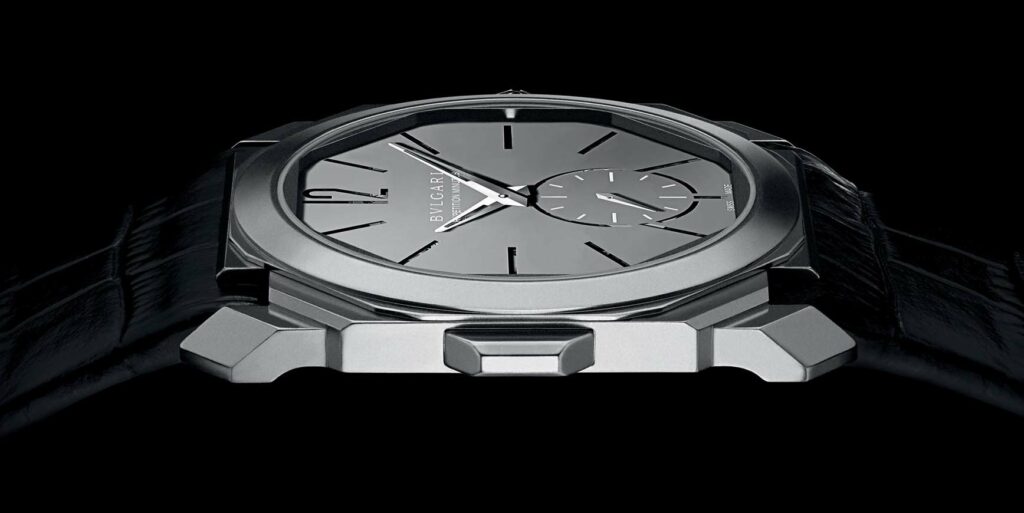
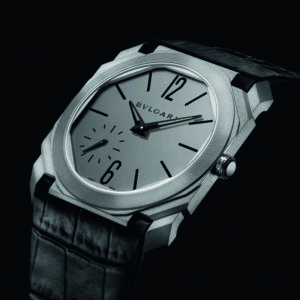
The 2017 Octo Finissimo Automatic was an instant classic: The thinnest automatic watch ever produced, it also featured the thinnest-ever automatic movement! Piaget had long held the record with the legendary 12P, but Bulgari beat them by 0.07 mm with Cal. BVL 138. This movement is clearly related to the hand-winding Cal. BVL 128 but has a micro-rotor for automatic winding in place of the power reserve indicator. The watch measures just 5.15 mm thick like the hand-winding model but is housed in a lightweight and stiff titanium case that measures 40 mm across. This material allowed the company to drop the list price to just US$12,800, and it remains the most affordable and popular member of the Octo Finissimo family today.

The Octo Finissimo Automatic did not hold the record for “world’s thinnest automatic watch” for long, however. Bulgari themselves surpassed it just a year later with the 2018 Octo Finissimo Tourbillon Automatic! This record-busting watch was not just the thinnest automatic watch with the thinnest automatic movement, it was also the thinnest tourbillon watch, breaking the record of the 2014 original! The new Tourbillon Automatic case measured just 3.95 mm thick, and the movement, Cal. BVL 288, matched the original Tourbillon at 1.95 mm. This was achieved thanks to a peripheral winding rotor, a rarely-seen technology that has often proven more trouble than it was worth. Like the original, the flying tourbillon is the thickest movement component and is highlighted by a “porthole” in the back of the otherwise-solid case. Just 50 examples were produced of the original, followed by another limited run with a CTP case the following year.
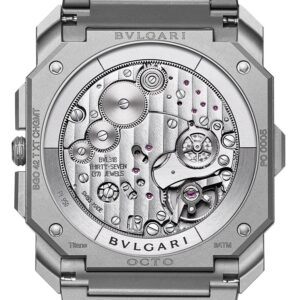
Bulgari turned to complications in 2019, with a record-setting automatic chronograph. The Octo Finissimo Chronograph GMT uses peripheral winding like the Tourbillon Automatic wrapped around a thin chronograph movement. Unusually, the monopusher chronograph Cal. BVL 318 has three push buttons around the case: One for the timing complication, one to switch the function of the winding stem, and one to advance the independent central hour hand. A running 24 hour subdial sits at 3:00, another unusual design choice. The chronograph uses a column wheel and horizontal clutch, a concession to thinness, but the overall movement is 3.30 mm thick. Like the non-chronograph Octo Finissimo Automatic, this titanium watch is surprisingly affordable for such an exotic piece, priced at just US$17,600.
Further complication was in store this year, with the introduction of the remarkable Tourbillon Chronograph Skeleton Automatic. Tourbillon chronographs are rare enough, but an ultra-thin automatic is unheard-of. Cal. BVL 388 is slightly thicker at 3.50 mm but is remarkable in its design. Completely open-worked, the movement is only loosely related to the previous peripheral automatic movements. The tourbillon is held in place with bridges on both sides, though it is still highly visible thanks to the open design. the dial layout is completely different from the Chronograph GMT, with chronograph minutes at 3:00, but they both have running seconds at 9:00. It’s not the thinnest tourbillon, chronograph, or automatic, but it is the thinnest combination of all three! It’s also incredibly rare and expensive, with just 50 produced at US$142,000.
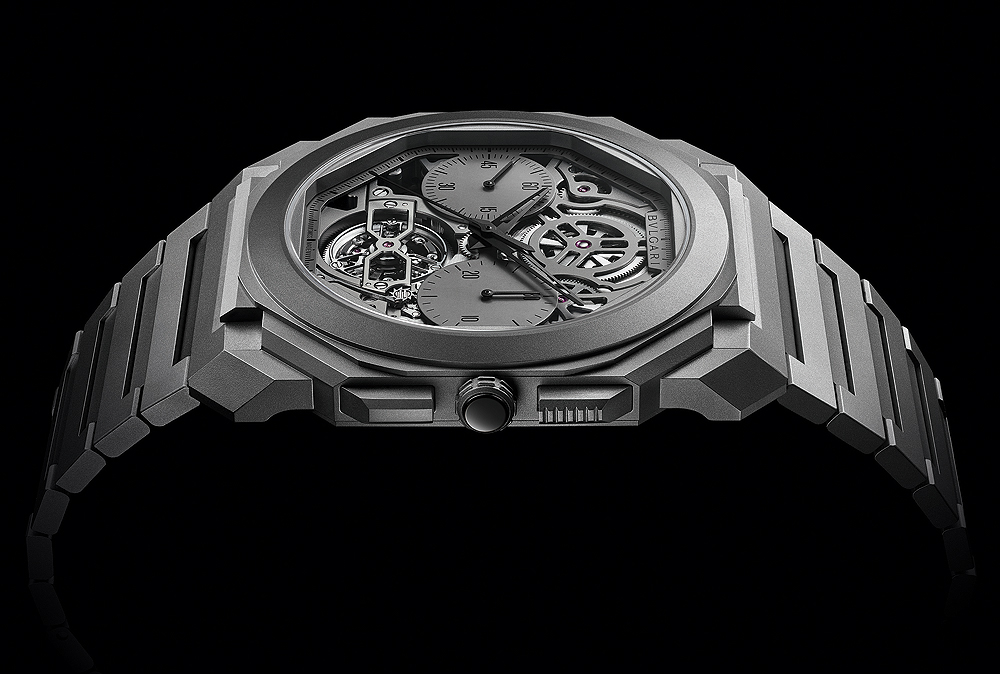
Research Notes
Combing through the history of the Bulgari Octo Finissimo family would seem to be straightforward, since the line began only in 2014 and every model was notable and well-covered. But it was complicated by a lack of technical information from Bulgari and some conflicting information “in the wild” regarding movement sizes and dates.
Once again, I turned to company catalogs and the Internet Archive as primary sources for my research. I was able to track down catalogs in pdf format for 2014, 2015, 2016, and 2017, and of course the current website shows 2020. But a website redesign for 2018 and 2019 isn’t included in the Archive, making it surprisingly hard to find information about the record-shattering Tourbillon Automatic. There are very few official press images of this movement, and it can be difficult to locate the watch in contemporary publications. Luckily my collection includes issues of Watchtime through this period, and I hope that their reporting was accurate. I requested access to Bulgari’s “press lounge” but have not yet been approved.
Like many manufactures, Bulgari does not publicize many technical details of their movements. So there is no official source for the diameter of the recent Cal. BVL 388, and I had to rely on secondary sources for the diameter of Cal. BVL 288 and others. I was also surprised by the lack of information about the marvelous construction of the ball bearing wheel train for Cal. BVL 268, though there were some lovely photos in company catalogs. Still, Bulgari does not always publicize the “bare” movements in images, so I was thrilled to locate official photos of all seven.
It is also difficult to nail down the exact models of various Bulgari watches. Their catalogs are not exhaustive, highlighting models and materials but not listing the various combinations. The Internet Archive helped a lot with this, since it usually did list model numbers. And on that note, Bulgari’s tendency to use non-sequential numbers for related models came as a surprise to me! Still, I was able to uncover some interesting details, including the remarkable Diva Finissima, which is rarely mentioned anywhere.
The Grail Watch Perspective: Bulgari Octo Finissimo
Finally, I will note that Bulgari deserves more credit than they usually get for this line of watches. The fact that they set so many records year after year is eclipsed by the fact that they set so many important ones: Thinnest automatic watch, thinnest automatic movement, thinnest tourbillon, and thinnest chronograph. And even more remarkable is the fact that the Octo Finissimo Automatic and Octo Finissimo Chronograph GMT are so affordable, priced under US$20,000. Although that’s a lot of money, it’s not a lot for an exotic record-setting haute horology piece!
Note: All images of the Bulgari Finissimo family are official Bulgari press images
Leave a Reply